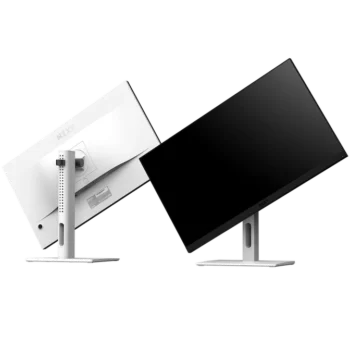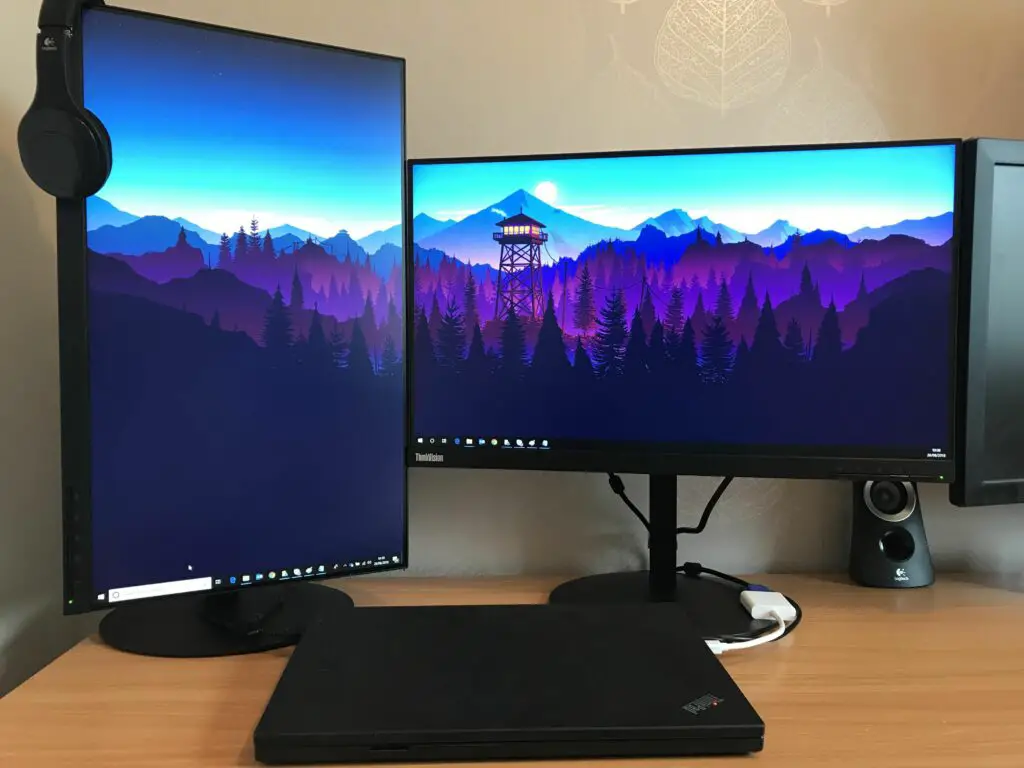Elevate Your Viewing: The Top 5 Vertical Monitors of 2023

Have You Considered Going Upright With Your Screen?
The world seems broad. Our computer screens, usually stretching out in the landscape, would agree. Yet, have you pondered flipping that view upright? Let’s unpack the idea of switching to a vertical monitor setup:
- The Usual Way: We’re cozy with our wide screens, perfect for movies and spreadsheets.
- The Vertical Spin: But tilt that view 90 degrees and discover a new world. Does it work for everyone? Not quite.
Now, the journey begins:
- Discover the Vertical: We introduce the vertical monitor, a twist to the norm.
- Evaluate Your Needs: You’ll see why flipping your screen might click with your workflow.
- The How-To: Curious about making the switch? There’s a guide for that.
And then, a sprinkle of comfort:
- Life Hacks: Tips to make a vertical monitor more than just practical, but a delight.
Here’s the cliffhanger:
- What if your gaming could level up with the best OLED gaming monitor flipped vertically?
Stay with us, and we might reveal how to turn your workspace into an ergonomic playground. Ready to flip your perspective?
What Is a Vertical Monitor?

Have you ever noticed that monitors usually stretch wider rather than taller? That’s the horizontal layout we’re all used to. But what if you spin a monitor so it stands tall, like a skyscraper in a city skyline? That’s a vertical monitor for you.
- Traditional Horizontal Layout: Like a landscape photo, it’s vast.
- Vertical Monitor Layout: Like a portrait painting, it stands tall.
So, why go vertical?
- It shows more on a page. Think of a giraffe; it sees more from up high, right?
- It makes coding and reading like a breeze. Less scrolling, more seeing!
But just turning your monitor won’t do the trick. Imagine turning a picture on the wall; it looks odd, right? You have to tell your computer to flip the display, too. Otherwise, everything looks sideways!
And here’s a nugget for you:
- Did you know the oldest monitors were square? A vertical monitor is just an old-school square with a twist.
Now, how could this tall setup fit into your life? Or what’s the catch? Well, let’s keep the suspense hanging. Will it be a game-changer or just a space saver? Stay tuned as we explore more.
Why Do You Need an Upright Screen Setup?
Is a vertical monitor right for you? It’s not a one-size-fits-all answer.
- A vertical monitor might be a game-changer or an unnecessary twist, depending on your daily tasks.
- For those who juggle long codes or documents, it’s like a superpower—seeing more without scrolling.
Think about programmers. They love vertical monitors! Why? Because more visible lines of code mean less scrolling and more doing. But here’s the twist:
- Could there be tasks where you’d thrive with a vertical view?
- Or may it crowd your digital workspace?
It’s all about how you work and play. Picture this: Your workflow but with everything in view—no more diving down the page. Is the thought tempting? Or perhaps there’s a reason you’d want to stick to the usual?
Before you decide, consider this: Does your day-to-day scream for a vertical leap? The answer could turn your world sideways—in the best way possible.
When Don’t You Need a Vertical Monitor?
Sometimes, a vertical monitor might not be your best friend. Here’s why:
- Horizontal Data: If your work looks better wide, like a sunset, then horizontal is the way to go.
- Window Snapping: Love snapping windows side by side? A vertical screen might cramp that style.
Consider how you use your browser. Is it a tab paradise? Having a vertical monitor means taking advantage of the whole picture. Plus, here’s a little secret:
- Most folks use a vertical monitor as their sidekick, not the main show. It’s like having a trusty assistant rather than a lead star.
And if you’ve got just one screen? Going vertical could be more of a puzzle than a solution. Will you miss the broad view, or will the tall, slender perspective open new doors? It’s like choosing between climbing a ladder or walking through a hallway—what will your move be?
Addressing Vertical Monitor Configuration Issues and Common Hurdles
Diving into a vertical monitor setup can be challenging sailing. You might bump into a few hiccups along the way:
- Blurry Views: Noticing fuzzy text? Tweak your display settings to sharpen things up.
- Stubborn Apps: Some programs prefer to stay upright. Hunt for those that do, or twist and turn your windows to fit.
But wait, there’s more:
- Mismatched Ratios: When your vertical buddy doesn’t match your horizontal pal, it’s time for window-dragging gymnastics.
And then there’s the health bit:
- Keep that monitor at eye level. No one wants a neckache, right?
- Also, are you eyeing the same spot for too long? Not fun. Regular breaks are key!
Now, here’s a sneaky one:
- Software Scuffles: Got an app that’s a vertical monitor’s nemesis? Flip the display just for that app.
Remember your graphics card. It’s the heart of the operation. Make sure it can handle the heat of multiple displays. And cables? They can be like untamed vines in a jungle. Tame them with clips and ties to avoid a tangled mess.
Curious about the next steps? Stay tuned. There’s more to unravel in the vertical tale. Will it be a smooth climb, or will you need to gear up for some tech acrobatics?
How to Set Up a Vertical Monitor
Setting up a vertical monitor is a two-step dance:
- Step 1: The Physical Move – You get hands-on and turn your monitor upright—just a simple twist. But wait, is there a lock at the back? Check for it, release it if needed, and swing your monitor.
- Step 2: The Digital Flip – Your screen’s standing tall, but everything’s sideways. Let’s straighten it out!
Here’s the magic move:
- Right-click your desktop, dive into “Display Settings,” and scout for the “Orientation” menu. Swap ‘Landscape’ for ‘Portrait,’ or play with the ‘flipped’ options to get it right.
And if you’re in the Apple orchard, it’s just a quick hop to “System Preferences,” a tour through “Displays,” and a tap on “90 degrees.”
Now, everything should look up and down just as it should. But is it all smooth sailing from here, or are there more twists to this tale? Keep reading to find out how this vertical leap can land.
Innovative Vertical Monitor Arrangements for Enhanced Productivity and Immersive Visual Experience
Spruce up your desk and boost efficiency with these vertical monitor configurations:
- Straight-Up Portrait: Turn your screen 90 degrees. It’s a no-fuss setup ideal for marathon coders or avid readers.
- Sky-High Stacks: Imagine stacking your monitors one atop the other. It’s a neat trick for when you need to compare, contrast, and conquer different tasks.
What about a setup that plays double duty?
- Combine a vertical screen for the nitty-gritty work with a horizontal one for when you kick back. Could this be your productivity secret weapon?
And for the trendsetters:
- Have you seen those curved screens? Flip one vertically and dive into a wrap-around view. It’s like stepping into the future, but is it too bold for your taste?
If you’re feeling crafty:
- Why not build a monitor mount that’s just yours? Adjust, angle, and align it until it’s perfect. But will it be as easy as it sounds?
Always remember, the key is comfort. Position your screens where your eyes and neck say “thank you.” Will one of these setups catch your eye, or will you invent something entirely new? Keep tinkering until everything clicks into place.
Vertical Monitor Setup Tips for an Elevated Quality of Life
Enhancing your space with a vertical monitor doesn’t stop at just flipping a screen. It’s about crafting a workspace that’s a joy to use:
- The Dual Dance: Got two monitors? Swing one into vertical mode and hit “Extend” in your display settings. Now, you’re not just working; you’re orchestrating.
But why stop at two?
- The Triple Treat: More screens, more space, more zest. Arrange them just so, with your primary canvas in the center. It’s like being the conductor of an orchestra.
Are you a team laptop?
- Plug in an extra monitor, and voilà, you’re doubling your view. Can you handle triple? Go for it if your laptop can keep up. But here’s the kicker:
- Pixels: Think of them like digital grains of sand. The more you have, the smoother your digital beach. Nowadays, 1080p is your baseline for clarity, but be bold in going higher if you crave crispness.
And one more thing:
- Arms Race: Those monitor stands that came in the box? Swap them for arms. With a monitor floating like a cloud, you can twist, turn, and tilt to your heart’s content. How high or low will you go?
Imagine the possibilities. Will your workspace transform into a productivity powerhouse, or will you find new ways to streamline and simplify? The choice is yours to make.

